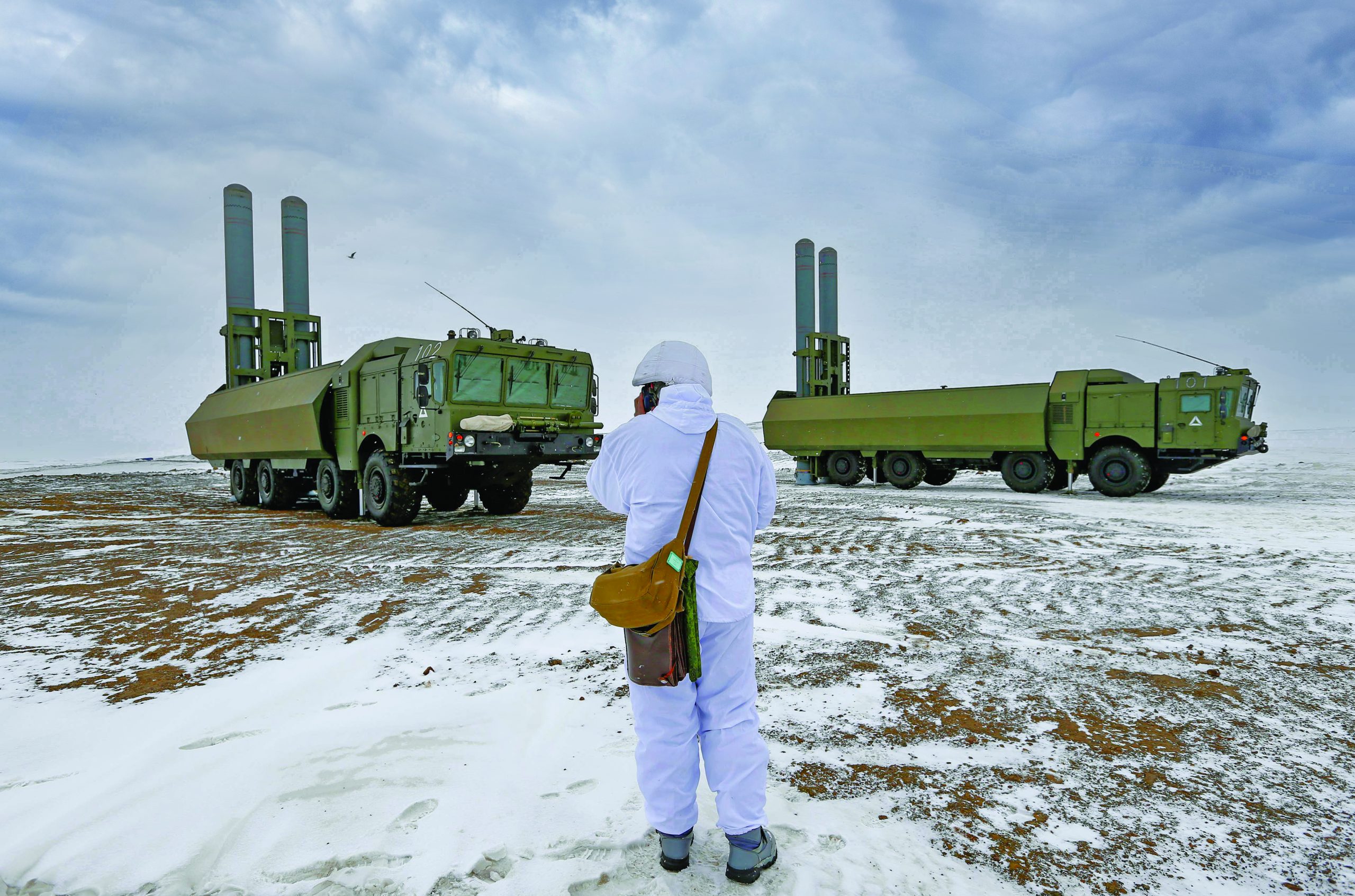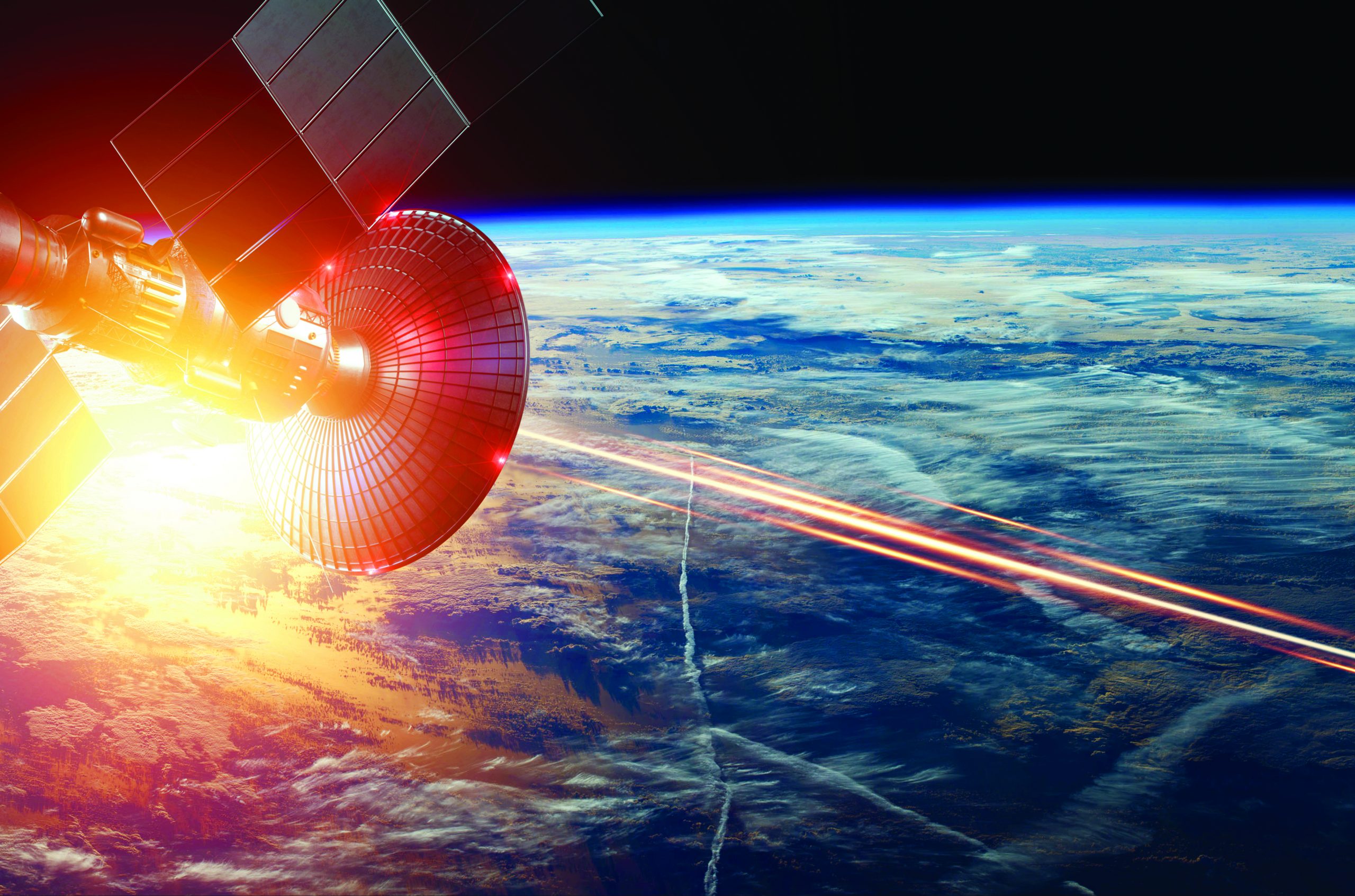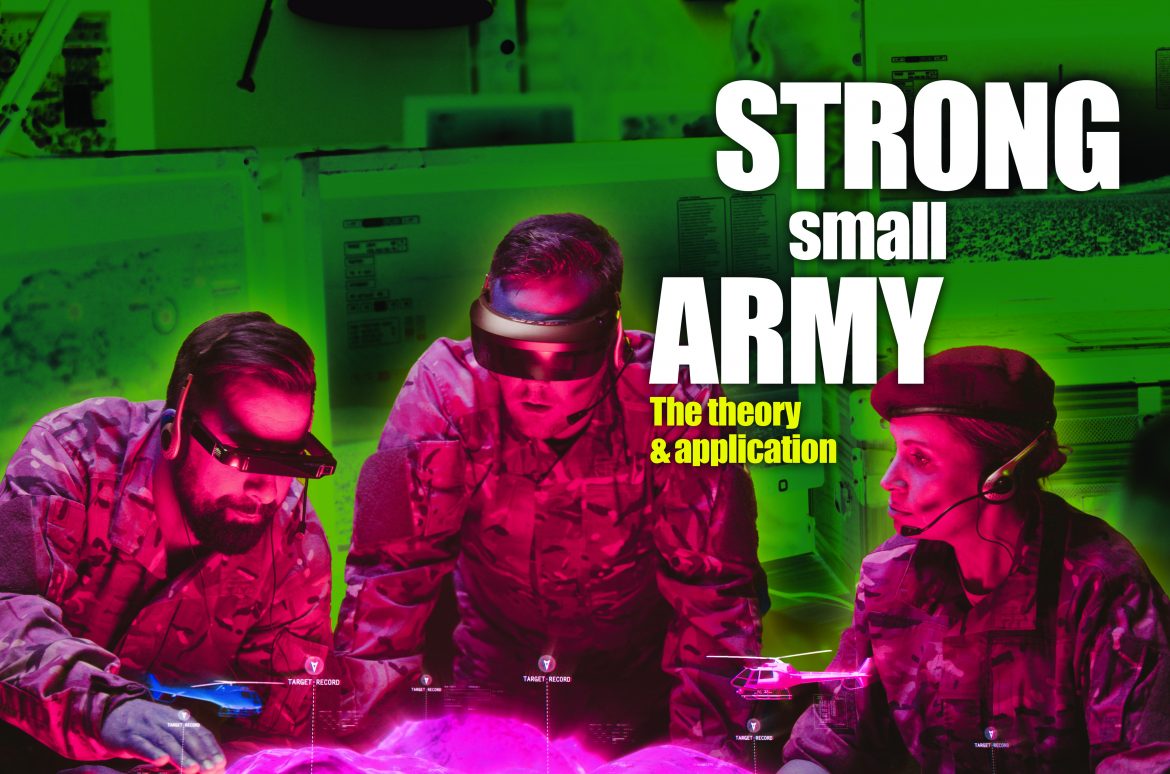The concept of a “strong small” army means providing the armed forces with the latest generation of weaponry and equipment, which provide agility and intense target-focused fire mobilization, as well as accuracy, with superior ability to transfer and exchange information on the field of battle, or between the forces and command centers, allowing operations to be carried out by a limited number of troops, confronting enemies that outnumber them, reducing the need for deploying a large number of fighters into the battlefield or moving corps and divisions from one battlefield to another.

The idea behind this concept calls for relying on advanced information technology, to enable the forces to accurately identify, monitor, follow up, and hit targets from long and secure distances, and the force required to carry out these operations has to be small in number, can move fast, highly trained and don’t have to engage in direct battles with the enemy, except when necessary.
This concept is based on reducing the role of the ground forces in favor of the air force, which plays a vital role in battle, as the strong small army has to have a technically advanced air force that can carry out preventive and preemptive strikes on sensitive targets, destroying the enemy’s factors of superiority in the early hours of the battle using its strong and highly precise offensive air weapons, which have a great ability to penetrate hostile air defense, paralyze it and reach their goals.
In addition, that army must possess a wide variety of electronic warfare systems, command and control systems, intelligence, cyber and communication systems (C4I), and projectiles to suit the required tasks, as well as providing advanced training for troops and commanders.
Regarding ground warfare, cross-border threats and conflicts in many regions drove the world to modernize the weapons of ground forces and seek more efficient systems compared to models tested in previous wars, this resulted in a fundamental shift in favor of the land weapons industry to meet the need for this qualitative development.
The small size of the ground forces allows for effective coverage and protection by both short and medium-range air defense systems and so the concept of a strong small army focuses heavily on Special Forces, providing them with the latest equipment, as well as the ability to deliver them behind enemy lines.
In naval warfare, the focus is on owning fast and small missile naval vessels that are difficult to detect with different sensors, increasing the range of fire, and deploying long-range missile and artillery coastal defense systems.
For example, the K-300P Bastion-P missile is a Russian coastal missile defense system (known in NATO as SSC-5) designed to counter various types of surface ships and can operate in conditions of intense electronic jamming and obstruction.
The Russian version of the system relies on P-800 Oniks missiles, while the export version uses P-800 Yakhont missiles, with a range of up to 300 km and a speed of Mach 2.6.
This type of force (ground, air, and sea) requires coordination between all the divisions of the military, in a framework known as the joint arms battle, and effective intelligence services that ensure the delivery of information about the movements and intentions of the enemy and the changes it is making in its forces.
After World War I ended, many studies evaluated the weapons used in this war, which produced the concept of a strong small army adopted by several leaders, such as Charles de Gaulle in France, Liddell Hart in Britain, and Seeckt in Germany, who called for the construction of small armies that would have a strong impact due to the quality of their weapons, especially armored vehicles with characterized by the ability to penetrate defenses and enemy fortifications, agility, firepower, and protection for the crew.
However, some military experts believed that this concept reduces the role of the soldier, pointing out that the Second World War (1939-1945) emphasized the vital role of the fighter in any war, as the operator of any machine.
The role of technical progress
Any party’s possession of advanced military technologies requires the enemy to develop counter technologies.
For example, with the emergence of submarines in warfare, naval mines that are planted at great depths were developed and with the use of tanks, came anti-tank ballistics.
Similarly, with the emergence of warplanes, came the development of air, artillery, and missile defense systems, both mobile and stationary, and with the development of radars in World War II, and their use in detecting and tracking air targets, stealth missiles appeared, and used for the first time in the Vietnam War.
The invention of ballistic missiles, spurred the development of missile defense systems to counter them at different ranges, and with the expansion in the use of drones for reconnaissance and airstrikes, such as what is happening now with the Russian invasion of Ukraine, systems capable of monitoring and destroying them are being developed despite their small size, compared to other air platforms, which indicates that the development and use of technologies prompt the use of counter technologies, and that mere possession of these technologies and their use in the battlefield does not guarantee victory, but rather emphasizes the importance of training and raising the efficiency of the human element at all levels.
In time weapons were developed, formations density and distribution flexibility increased, and efforts were made to provide protection for fighters, through individual armor, and then the full iron suit, in light of the expansion of the range of advancement and combat equipment.
The invention of gunpowder sparked a new era, in which firearms of all kinds prevailed and efforts to develop means of transporting explosive materials spread, whether by land through artillery and missiles, by air through various aircraft, or by sea using ships and submarines.
Therefore, the capabilities and means of destruction remained the same, while the technical development focused on means of transportation, and thus more focus was on increasing the range of the guidance technology to increase precision, resulting in the development of radar, television, thermal, laser, and eventually satellite guidance.
During World War II, 1500 B-17 bombers developed in the 1930s had to drop 9,000 bombs, each weighing 2,000-pound to destroy targets in an area of 60 by 60 square yards, yet in 1970, during the Vietnam War, 176 similar bombs were dropped by 88 F-4 Phantom II fighter-interceptor to achieve the same goal.
In 1991, during Operation Desert Storm, only two laser-guided bombs, fired from a single F-117 Nighthawk (decommissioned in April 2008), were needed to achieve the same goal.
By the beginning of the 21st century, electronic computers underwent a huge development, becoming capable of processing large amounts of data, leading to the development of integrated armament systems, which were characterized by high accuracy, and supported by artificial intelligence.
In 1991, the international coalition forces tried to test some elements of this theory during the war to liberate Kuwait by launching a 39 days air campaign, characterized by the expansion of the use of highly accurate drones, which carried out hundreds of various missions.
Thanks to the accuracy of the drones against ground targets, the ground campaign of the coalition forces did not suffer any significant casualties.
In Bosnia, the Americans used the Joint Surveillance Target Attack Radar System (JSTAR) system to monitor the operating theatre from the air, enabling them to determine the location and model of any type of machinery traveling on the ground across 200 square kilometers, on one screen, and in any climate.
With the development of guidance technology came the emergence of automatically-directed missiles and drones, which use GPS to ensure strong accurate strikes on hostile targets from vast distances.
There is also a system of sensors collecting and processing data, in one place, in real time, leading to an increase in the effectiveness of the integrated circuits (information – decision – action) to provide forces with quick and high performance, and thus maintain initiative and decisiveness in the fight.
Similarly, the decision-making processes will change to include a mixture of “artificial and human intelligence, and these processes will be less sequential, and more immediate.

The new revolution in military technology revolves around achieving superiority in three fields:
1- Gathering information, as the sensor centers in satellites and aerial platforms can capture everything that moves in a specific area, ground, sea, or air, and in any weather.
2- Processing information, which is done through advanced command, control, communication, and information systems, that interpret the information they receive from sensor centers and display it on the screen, and then these systems assign weapon platforms to carry out specific tasks and distribute information about friendly and hostile forces at all leadership levels.
In this context, the US armed forces seek to develop an integrated system that unifies the information between every division of the military instantly wherever they are.
The US armed forces also strive to develop secure means of communication via the Internet, allowing everyone on the field of battle to obtain any information needed directly.
3- Using all the information to bomb long-range targets with great accuracy, for example, cruise missiles guided by satellites, can hit a building hundreds of miles away.
On March 19, 2022, the Russian Defense Minister announced that his forces had used their latest hypersonic missile for the first time to destroy a weapons storage site in western Ukraine, the Kh-47M2 Kinzhal air-to-ground missile Kinzhal (AKA the Dagger) which is an air-launched ballistic missile, built to arm the modernized MiG-31K long-range fighter-interceptor. According to the Russian military, this missile is capable of hitting targets at distances of more than 2,000 km, at a speed of up to Mach 10, making any modern missile defense system useless. However, history proves that technology does not guarantee military superiority, even if it enhances operational management.
In ancient times, Rome used Greek fire to repel the attacks of the “barbarians” for a time, however it could not stop their advance. In the middle ages, the Knights of the Plains conquered the fortifications of the great cities of China, Persia, Iraq, and Eastern Europe.
In our modern world, the more advanced forces rarely managed to beat the less developed enemies, for various reasons, such was the case in the Vietnam War and the American invasion of Afghanistan.
Even though information technology promotes efficiency and the discriminatory use of weapons with fewer casualties, many overestimate the difference it can make in wars on its own, however, it can provide vital support for these forces.
A new system to arm the small strong army
Among the most important tools in the arsenal of a strong small army will be weapon systems that can strike deep into enemy territory, and that allow the use of modern technologies to achieve operational control, as well as long-range artillery systems with “smart” munitions, combat and reconnaissance drones, and airborne forces capable of combat in remote locations, in addition to special forces, will give the small army a real ability to fight deep battles.
The cohesion of these weapons will support the war effort to achieve a relative superiority in direct fire engagement with hostile forces.
Modern missiles have become so accurate that each side seeks to strike first to prevent the enemy from retaliating and at the same time, military operations expand geographically, while the number of troops and machinery used in them decreases. Since anti-missile defense won’t always be easy, ports, air bases, and any fixed positions will be vulnerable to attack.
New levels of training and education
To fulfill all the required tasks, a strong small army needs leaders who have leadership skills, flexibility, and creativity, can adapt to battlefield conditions, and carry out the tasks assigned to them.
Therefore, leaders’ training is an essential part of the plan to raise the levels of training
Weapon systems’ technological development requires that fighters adapt to this technology and learn to use it to the maximum extent. Without thinking about such things in advance, and good planning, training is done at the wrong time, by the wrong officials, or even at the wrong stage when using new weapons.
Training’s effectiveness increases when it is gradually applied, or done at the appropriate time, and the modern military training system relies on training using virtual warfare techniques (simulators), and war games to train commanders and staff, in addition to conducting maneuvers at their various levels, and joint training with friendly forces.
Legitimate questions
How can the new revolution affect the way armies fight and organize?
Will this revolution lead to a change in low-intensity conflicts, such as guerrilla warfare?
How easy is it to resist modern technology?
Do these technologies guarantee victory for those who own them and master their use? Or are they just a power multiplier?

Radical changes to the implementation process
The implementation of the concept of a strong small army requires radical changes in security and defense affairs, according to a set of criteria and considerations, which in essence aims to reduce the numerical and organizational size of the army, making it smaller, more efficient, and allowing for optimal utilization of the available manpower, which in turn helps increase the ability to provide the army’s armament and organizational needs as well as accommodate the latest technical developments in weapons, through the following steps:
Transitioning from a system that relies heavily on conscription to volunteers who are encouraged with financial incentives for a longer period of service, notably 17 European countries have abolished conscription since the beginning of the 21st century.
For an ordinary soldier, service includes a period of basic training followed by a reserve period. As for the craftsmen, whose numbers are expected to increase steadily, they are covered by long-term service contracts, which are subject to renewal.
·Setting criteria for selecting commanders and staff officers by focusing on quality and resourcefulness in all fields.
Preparing to defend with a small working army with early warning capabilities, airpower, fleet, mobilization, and effective reserve transportation system.
Developing command, control, reconnaissance, and intelligence systems, so that commanders can obtain a realistic and unified view of what is happening on the battlefield to help to make rational decisions and allocate correct immediate combat missions to units.
Supporting the conventional deterrent force by developing ballistic and cruise missiles, and arming submarines and ships with missiles that target land targets at a distance.
Developing training and qualification methods for commanders and officers of various levels, so that they can deal with complex problems and emergencies on the battlefield.
Deepening and expanding the scope of strategic alliances with major powers, especially in various military fields.
Boosting the role of the Air Force to be able to make impressive achievements.
Challenges of Urban War
The belief in the strategy of relying on technical ability and the speed of military operations prevailed in some circles of senior military leaders in some countries throughout the last two decades, which led to ambitious plans to restructure the armed forces to reduce their numbers and provide them with the latest weapons, based on the belief that the Air Force will be the striking force in modern warfare, instead of ground troops, and that this war does not require the enlistment of huge armies on the ground, as much as it requires Complete control of the airspace, i.e. fewer more advance forces.
These fewer forces must be fast, deployable, heavily armed, well trained, with a high ability to maneuver, circumvent and penetrate, depending on an advanced electronic system, which allows it to operate as a network with a harmonious performance.
However, urban warfare proved to be the biggest obstacle to these plans, because even though there has been great progress in the collection, processing, analysis, and use of information, cities are still able to mislead military planning based solely on it, as complex streets, overlapping road networks, and population topography prevent commanders in remote command posts from seeing things clearly.
Therefore, urban warfare is considered a modern model of guerrilla warfare, in which anti-armor and anti-aircraft projectiles, suicide operations, improvised explosives, and ambushes are used, and adversaries are prepared to use a combination of conventional and unconventional weapons and tactics, attack civilians, or launch suicide attacks, and engage in criminal behavior to achieve its goals.
Thus, this war incorporates a combination of different fighting styles, tactics, and disorganized formations, to take advantage of all forms of combat, and armed groups seek to drain and exhaust their enemy to force it to withdraw from certain territories.
Cities have become the battlefields of the future as urban warfare presents challenges and costs that can far outweigh conventional warfare, most prominent of which is undermining the superior effectiveness of weapons and communications, in addition, urban warfare poses special challenges to the technically superior regular forces facing armed groups, as this type of war greatly reduces the effectiveness of advanced weapons and sensors while creating a favorable environment for less sophisticated weapons and guerrilla tactics, which includes using buildings as hiding places for defenders.
Conclusion
The concept of a strong small army depends on the fact that the nature of warfare will change dramatically in the future, as those large armies will be absent, and militaries will become more inclined to reduce numerical strength in favor of increased efficiency, taking advantage of technological advancements in the development of weapons.
Meaning that the army of the future will be a strong small army, which depends on quality rather than quantity, thus enabling it to double its presence and strength while eliminating its direct military presence on fixed bases, drawing on technical development in the field of information and communication to abolish the concept of “spatial presence”, so that it relies on advanced methods of combat, which depend on the army being stronger, better, and less expensive.
« Major General Dr. Ali Muhammad Ali Rajab
(military researcher and strategic expert)













